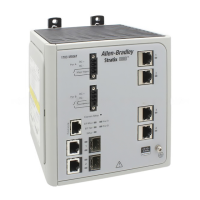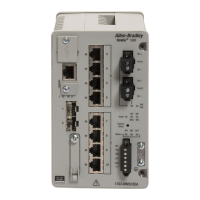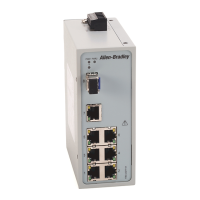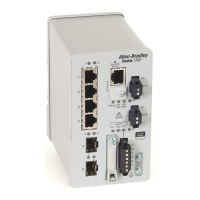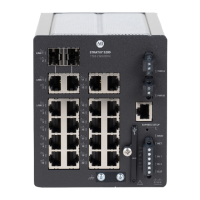Rockwell Automation Publication 1783-UM003G-EN-P - December 2012 33
Switch Software Features Chapter 2
Spanning Tree Protocol
Spanning Tree Protocol (STP) is a Layer 2 link management protocol that
provides path redundancy while preventing loops in the network. For a Layer 2
Ethernet network to function properly, only one active path can exist between
any two stations. Multiple active paths among end stations cause loops in the
network. If a loop exists in the network, end stations might receive duplicate
messages. Switches might also learn end-station MAC addresses on multiple
Layer 2 interfaces. These conditions result in an unstable network. Spanning-tree
operation is transparent to end stations, which cannot detect whether they are
connected to a single LAN segment or a switched LAN of multiple segments.
The STP uses a spanning-tree algorithm to select one switch of a redundantly
connected network as the root of the spanning tree. The algorithm calculates the
best loop-free path through a switched Layer 2 network by assigning a role to
each port based on the role of the port in the active topology:
• Root—A forwarding port elected for the spanning-tree topology
• Designated—A forwarding port elected for every switched LAN segment
• Alternate—A blocked port providing an alternate path to the root bridge
in the spanning tree
• Backup—A blocked port in a loopback configuration
The switch that has all of its ports as the designated role or as the backup role is
the root switch. The switch that has at least one of its ports in the designated role
is called the designated switch.
Spanning tree forces redundant data paths into a standby (blocked) state. If a
network segment in the spanning tree fails and a redundant path exists, the
spanning-tree algorithm recalculates the spanning-tree topology and activates the
standby path. Switches send and receive spanning-tree frames, called bridge
protocol data units (BPDUs), at regular intervals. The switches do not forward
these frames but use them to construct a loop-free path. BPDUs contain
information about the sending switch and its ports, including switch and MAC
addresses, switch priority, port priority, and path cost. Spanning tree uses this
information to elect the root switch and root port for the switched network and
the root port and designated port for each switched segment.
Rapid Spanning Tree Protocol
Rapid Spanning Tree Protocol (RSTP) (IEEE 802.1D-2004) uses point-to-point
wiring and provides rapid convergence of the spanning tree. RSTP is enabled by
default.
If you are connecting the switch to a Cisco network switch, the
typical default is PVST+, not RSTP. To provide compatibility, one
or the other switch will need to be modified.
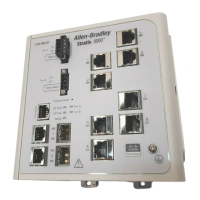
